#king of lineland
Explore tagged Tumblr posts
Text
Guys what is this book and what is the Bill on it? All I know is gay shapes-
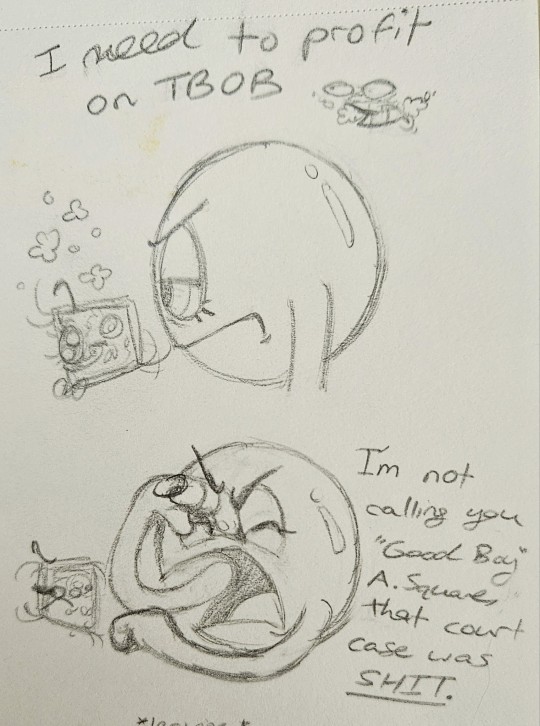
A. Sphere: I'm not calling you "Good Boy" A. Square, that court case was SHIT.
Me earlier: Wow! The Book of Bill just came out, that's cool ig.
Everyone recently: *being super active in the tag, watching the movies, relogging and liking my art*
Me: *me carrying some small doodles over* WHO ARE YOU PEOPLE???
Thanks for bringing me back to brainrot by spam-liking all my old posts guys I forgive none of you (/J I LOVE YOU ALL)
More stuff below cut (BE WARNED NEW FLAT-PEOPLE SOME OF IT IS LOWKEY SPOILERY):
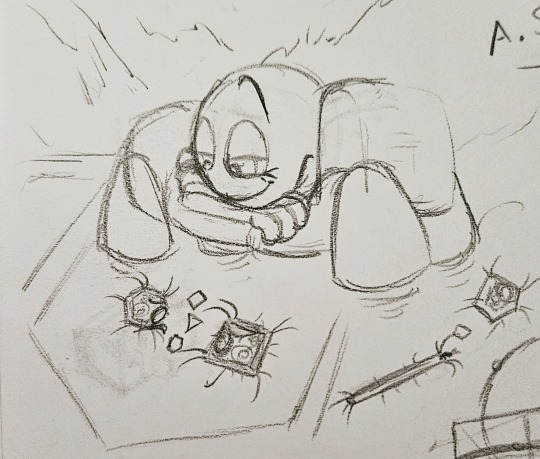
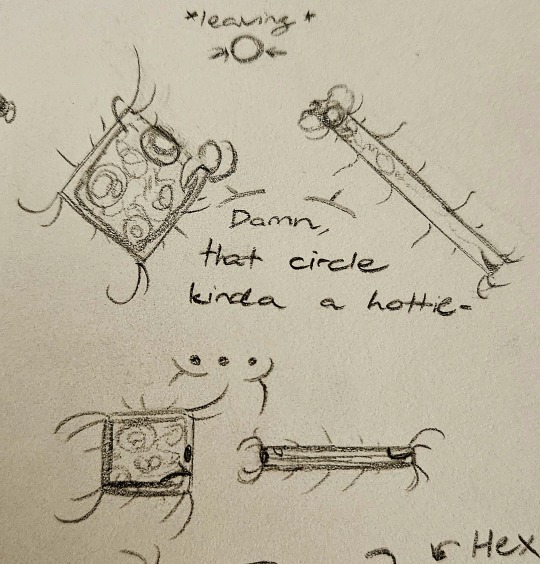
A. Square and A. Faux Line: Damn, that circle kinda a hottie- ...
I had this silly idea after my 29374th time watching Flatland that a majority of the first part of the movie is just A. Sphere watching all the shit go down like the worst telenovela you've ever seen. Also, that A. Line was originally going to be the apostle, but... uh... she can't really do that anymore, so he banks all his money on A. Square.
Also, I thought it would be super funny of A. Square and A. Faux Line both crushed on A. Sphere when he first showed up lol. Crazy smooth priest spawns and everyone swoons.
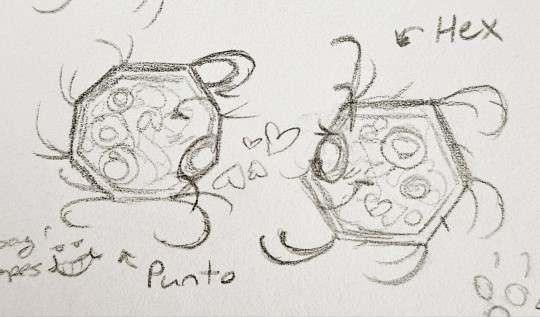
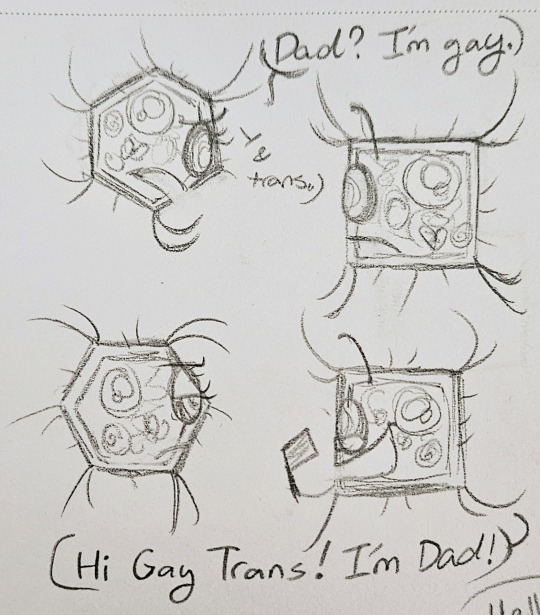
Older Hex doodles too. I love Hex, they're such a real one the whole time. With all the faults of Sphereland, I do like Hex maining in that one. But I also like picking and choosing which things I take as canon in my own work, so you get young adult Hex with their totally not-romantically-involved-with-at-all partner Punto (P. Octagon).
It's been a bit since Flatland happened in this hypothetical, so A. Square's still around. He's trying to be supportive of his masc-nonbinary kid who likes kissing boys, but still has to be annoying with dad jokes and the occasional backhanded compliment. He means well tho.
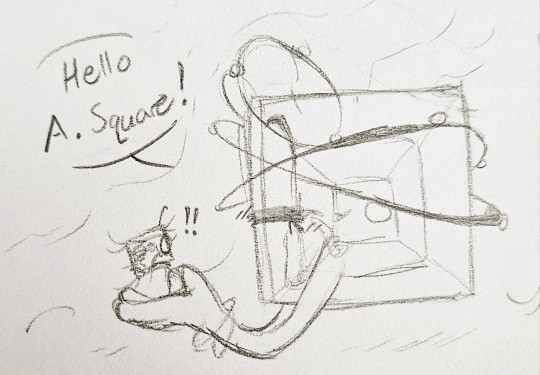
A. Tesseract: Hello A. Square!
A. TESSERACT OH HOW I'VE MISSED YOU POOKIE <3333. She's probably one of my most favorite ocs I've made (and the one that gets the most art <3) She's also the one I feel the least awkward about shoving into the source material lol. I yearn to work on A Heightlander's Escape again, but we'll see.
I just wanted to draw something cute between her and A. Square. She may or may not be the voice at the end of the movie hmmmmmmmm.
At least A. Square would end up in good hands.
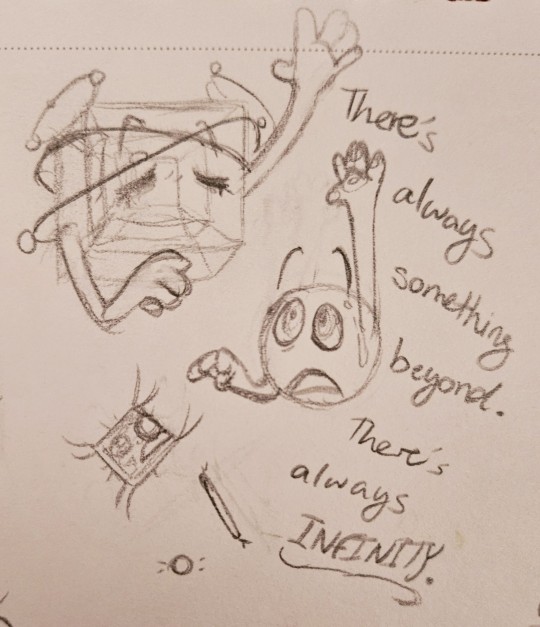
"There is always something beyond. There is always INFINITY."
Just a little doodle of smth I may or may not render cuz I really like how it looks. There is always something greater after all.
Thank you all for the recent support on those old-ish drawing, y'all made my week tbh. I have a new AU cooking for this so look forward to that lol. Have a good one :)))
#WHERE DID ALL YOU PEOPLE COME FROM LIKE ACTUALLY HUH???????????????#I KNEW THE BOOK WAS POPULAR BUT HOLY BALLS THAT'S A LOT OF YOU#also squaresphere nation rise up even if i ship it in the most toxic doomed yaoi way possible#everyone needs to give hex and all the other characters more love in flatland 2007 please they're all so good#but keep the a sphere art coming i'm eating all that shit UP#also feel free to ask anything about a. tesseract i love yapping about her#flatland#flatland 2007#sphereland#sphereland a fantasy about curved spaces and an expanding universe#flatland a romance of many dimensions#flatland oc#flatland the movie#flatland the film#a square#a sphere#a tesseract#hexagon#a hexagon#punto#flatland au#a faux line#king of lineland#king of pointland#these dudes so easy to draw gonna tag 20000 thnigs for them#katiekatdragon27
269 notes
·
View notes
Text
king of lineland + monarch of pointland gijinka redesigns >_0
+ some old art


vv old designs vv [ that im pretty sure i havent posted here yet ]


i think i shouldve kept the sketchy linework 4 the monarch ,, im just gonna add them in future drawings
also i balded king of lineland
i dont even know why i added hair whydid i do tha
#flatland#king of lineland#monarch of pointland#gijinka#i might have 2 redesign my sphere AGAIN i feel the need 2 fix their color pallette#looking @ my old flatland art .. and i start 2 question myself
79 notes
·
View notes
Text
Baaaahhh!!!! Voice head canons,,,
I’ll maybe make another one but otherwise I just needed to outlet my brainrot
Art used:




#flatland#flatland a romance of many dimensions#a square#a sphere#monarch of pointland#king of lineland#voice headcanons#voice hc
30 notes
·
View notes
Text

[ID: a picture on a white background of an axolotl to the right, its composed of light purple colors with lighter on its bottom and tail fin. its pertruding appandages by its face have darker purple edges and even darker fins around t hem. its eyes are black with white dots to indicate stars. its doing a owo face. To the right of it are doodles of bill cipher, a sphere and a square or versions of them. they are in a vertical line formation. a sphere looks unhappy and a square you can see its innards, behind them is a line between a square and a sphere and above the line is an s-shape tetramino from tetris. The Axolotl says "The truth of the multiverse is empathy and axolotls not fascism & hate!" END ID]
Had this idea of a 5th dimensional axolotl speaking to the shapes. legally distinct (TM) 5th dimensional axolototl.
24 notes
·
View notes
Text
Wowza a flatland post? After all these years (months)? Anyways realistically what happens if you’re a linelander and another linelander dies right next to you? Does it decompose or do you forever have a dead body as your neighbor? If it does decompose, you still have a decomposing dead body as your neighbor. Idk just something to think about
10 notes
·
View notes
Text
@karl-raccoon-enjoyer i really loved your idea for what their dynamic afterwards would be and i wanted to write something for it
7 notes
·
View notes
Text
The characters' assumptions and biases that the author put in there on purpose

[ID: AN MS Paint drawing showing characters from the book Flatland: A Romance of Many Dimensions. At the top of the image, the King of Lineland, represented by a simple straight line, looks at the square narrator and says, "1x eye = female". The narrator, who is a square marked with a grey Mars symbol to show he is male, looks down at the Sphere, and says, "Not a straight line = male". The Sphere, represented by a circle with a grey questionmark to show unknown gender, looks at the Monarch of Pointland, and says, "[unknown criteria] = male". The point is marked with a grey nonbinary symbol, and says nothing, looking at no one. End ID.]
#Rjalker reads Flatland a Romance of Many Dimensions#Flatland#Flatlandaromanceofmanydimensions#A Square#The Sphere#The King of Lineland#The Monarch of Pointland#described images#described art
16 notes
·
View notes
Text
had this really odd dream where i was meeting my friend’s mom who only spoke german but when i tried to tell my friend to translate to her that i can only speak english and french she just looked my dead in the eyes and went, ‘start speaking german’
4 notes
·
View notes
Text
Ok so like, lineland was great fun in flatland. I always liked how the methods of "seeing"/awareness changed relative to dimensions. In point land, the king had no concept of sight, and considered all sound to be his own conciousness. This could be considered level one: no sight, no touch, poor hearing.
Lineland is heavily focused on hearing and singing, with it being the primary method of understanding your neighbours. The music from two mouths of a male linelander allows for their length to be determined after all. Touch is possible in this dimension, though like the line segments in flatland, it is lethal. So at level two, we have no sight, poor/lethal touch, and excellent hearing.
In Flatland we understand that the basic method of understanding is touch. I'm of the opinion that if the flatlanders evolved differently, they could theoretically perceive the way the linelanders do, however they just don't. Perhaps the addition of a new dimension is a problem here. Sight in Flatland is also learnable, but very hard. In my opinion, Abbot added these differences purposely, but I'll get to that in a minute. Level three has poor sight, excellent touch, and poor/no hearing (as a means of percieving the world around you).
Finally we have spaceland. Our own world, where we perceive primarily by sight and need a completely different method to get around in the event of blindness. So in my levelling system, we as humans don't often get around by hearing or touch, and have excellent sight.
I think this could be graphed as a curve if you really wanted to, but I think Abbot was possibly trying to reflect the changing of dimensions and how aspects of the next dimension are seen in the previous. This is a concept seen in mathematics after all, so tying a tool of flatland's classism (not teaching lower classes the skill of sight recognition) into this mathematical concept is rather elegant if you ask me. It's exactly the point of the book, to combine mathematics with social commentary, and I like that.
#flatlander#flatland 2007#autism#autism shitpost#a square flatland#flatland#lineland#pointland#spaceland#book#horrors beyond comprehension
47 notes
·
View notes
Text
I'm still trying to watch flatland the movie and I've just finished the part with the king of lineland and so far, Arthur's voice was a bit surprising but I got used to it, I love the king of pointland in this but...uh...
Why is the king of lineland a surfer dude?
9 notes
·
View notes
Note
your flatland art is SO GOOD RAHHHHHH
Thank you so much! I'm happy there are still people who enjoy my silly occasional Flatland art lol. I need to start posting more of these guys cuz as much as I love the Flat Dreams stuff, I wanna see my silly pookies more. The true Flatland content /j

Take a doodle for the ride btw, I'm happy you like my art^^
Have a lovely day :)
#koy chats#thank you for the ask^^#the tesseract is my oc btw for my flatland continuation/au i need to work on more lol#her name is A. Tesseract for those who don't know#i love all these sillies i need to see more art of them#especially a sphere whenever i see him i jump around a little#minus my oc but like... if you wannaaa... i won't stop you.....#also I finally figured out how to properly illustrate in Magma so I might do more doodles lol#flatland#flatland 2007#flatland the movie#flatland the film#flatland a romance of many dimensions#a heightlander's escape#a sphere#a square#the king of lineland#the king of pointland#a tesseract#request doodles#katiekatdragon27
197 notes
·
View notes
Text
FLATLAND VOICECLAIMS ! [ part 1 / 2 ]
changed spheres design a little, btw spheres star things in their face is makeup i dont think ive mentioned that yet
#flatland#voice claims#flatland a romance of many dimensions#flatland voice claims#a square#sphere#king of lineland#monarch of pointland#sorry im taking 4ever 2 finalize a design 4 the other flatlanders#also i know a squares like grandpa old blame my doawk phase 4 this#also yes im in the osc
40 notes
·
View notes
Text

Levels
Below we will analyze each of the worlds and some facts about 'em. Let's start!
Linealand Road

Lineland's Chapter 1-1 is a homage to the original Super Mario Bros. with its level design, which resembled the classic World 1-1 through its positioning of items, ? Blocks, and enemies like Goombas. The music is also remixed from the Super Mario Bros. overworld theme and the Super Mario World overworld theme.

Its skies are full of strange, surreal mathematical formulas, such as (translated into literary form) "Fire Flower is greater than or equal to some kind of Block divided by warp pipe". (As can be seen in the image)
Gloam Valley and Merlee's Mansion

The music of Merlee's Mansion has several interludes full of altered versions of Mimi's theme, however, the theme of Merlee herself is never heard throughout the entirety of Chapter 2.
The password 5963 can be read as 「ご苦労さま」 in Japanese, which means "You've been working very hard". Similarly, 41262816 can be read as「良い風呂に入る」, which means "Take a good bath"

The Bitlands

The Bitlands is a dimension located beyond Flipside Tower's yellow door in Super Paper Mario. It has a unique art style that makes the world look as if it was drawn on a grid, like pixel art. The overworld music in this world is an arrangement of the classic Ground Theme from Super Mario Bros. According to The InterNed, said overworld theme is titled "The Open Plane", while the music in the underground area beneath the two red pipes is titled "Nostalgic Underground", due to it being an arrangement of the Underground Theme from Super Mario Bros.
There is also a reference to the original Mario Bros in chapter 3-1

The Bitlands is also one of only two worlds where there is at least one boss in each section (Bowser in 3-1, who joins Mario's party after being defeated, Big Blooper in 3-2, Dimentio in 3-3, and Francis in 3-4), with Castle Bleck being the other world where this is the case.
Furthermore, including the optional Pixls, Barry and Tiptron, the player gets four Pixls in The Bitlands, which is more than in any other world in Super Paper Mario.
On the fortress that requires blowing up on a red X, there are some enemies that aren't normally attackable due to the fortress being too tall to jump on. These enemies don't require items to defeat though, as one can use Thoreau to grab the Bullet Bill Blaster's Bullet Bills and throw them back. One can also use Dashell, if obtained before Chapter 3, to jump off the fortress before it and use Princess Peach's Parasol to get on the fortress. This allows access to the other side of it that is normally otherwise inaccessible, and the ? Block that is normally destroyed with it can be hit (it gives a single coin).
This chapter is one of the ones with the most references, I will put all of these in a future part :)

Outer Space

Chapter 4 may not take place in the outer space above the , but rather that of another dimension. It was once the location of the kingdom.
If on the second visit to the level the player answers "no" to the prompt to use the space helmet, Tippi will personally attempt to convince them otherwise. After that, if the player says "yes" thrice, she will abandon the player in frustration, resulting in a Game Over. Upon further visits, the helmet is equipped automatically once they pass through the door. (If you want me to write all the absurd Game Overs, leave it to me in the comments)

Land of the Cragnons

It is the home of the Cragnons, a prehistoric race of primitive people with televisions and stereo CD players seemingly made of rocks. It is also home to the enemies of the Cragnons, the Floro Sapiens, who live underground with their king, who is the boss of Chapter 5.
The setting of this Chapter is similar to Chapter 5's in the original Paper Mario. In both Chapters, Mario must venture into a mountainous area (in Paper Mario, it was Mt. Lavalava, and here, it was the Gap of Crag), they both featured a comically-incompetent adventurer accompanying him during the Chapter (in Paper Mario, it was Kolorado, while in Super Paper Mario, it was Flint Cragley), and both had a plant boss (in Paper Mario, it was Lava Piranha, while in Super Paper Mario, it was King Croacus IV). Mario also gets a kind of hammer in both areas (in Paper Mario, it was an Ultra Hammer, while in Super Paper Mario, he gets a hammer-like Pixl named Cudge.)
Near the end of the game, during the final battle with Super Dimentio, the Land of the Cragnons is destroyed by The Void, but is restored following the destruction of the Chaos Heart along with all other demolished dimensions.

Sammer's Kingdom

It is destroyed by The Void in the main story, leaving nothing but an empty white space, but is restored after the story's end.
This land is ruled by King Sammer. It is most notable for being the location of the Duel of 100 tournament, in which challengers face off against 100 Sammer Guys. Only the first 25 Sammer Guys are faced in Chapter 6-1, while the rest are encountered in the three other chapters. However, in the main story, only the first 20 Sammer Guys are battled, and only 30 Sammer Guys are encountered.
In addition to the Duel of 100, Tippi and Tiptron's Tattles mention various other events held in the Sammer's Kingdom, such as the Sammer Guy Break Hour, the annual Sammer Guy BBQ, the Sammy Awards, and the annual Sammer Quiz; however, Mario and friends are unable to attend any of these in person.
The kingdom appears to be based on Japan, with "Sammer Guy" being a pun on "samurai".
According to Garson of the Flipside bar, The Underwhere, 1,500 years prior to the events of Super Paper Mario, the younger sister of Merlumina was entrusted with a Pure Heart, to give to the Sammer Kingdom's ruler to protect. Upon meeting however, Merlumina's sister and the Sammer King fell in love and she stayed behind. The two eventually married and had 100 children. Ever since, the number 100 has been sacred to the Sammer Kingdom.
After finishing the game, the gang may start the Duel of 100 over. As before, Chapter 6-1 has Rounds 1-25. After defeating Sunshine Flood, Mario and co. will be able to continue on to 6-2.
If the player returns to Sammer's Kingdom after finishing the Duel of 100, King Sammer will be found on Gate 1. He will say the Age of the Sammer Guys ended and that he sent the Sammer Guys on a tropical vacation. He also jokes that he will replace them with kitty robots. When Tiptron uses Tattle on him, she reveals he is planning to turn the Duel of 100 Battle Gates into a water amusement park.
During the battle, as the players advance to the next sub-chapter, the number of flags seen on the stage will increase by one (i.e. one flag on every stage of Chapter 6-1, two in Chapter 6-2, and so on).
When the player tries to go to Gate 2 after completing the Duel of 100, they will discover that the door leading there cannot be used, as if it has become part of the background. When Tattle is used on the door, Tiptron will say the door is sealed, which might be because the other Gates disappeared, and they are currently working on the water amusement park there. Oddly, when the player uses Tattle on the very same door while in 3-D, Tiptron will say the player can open it by pressing , the same as her Tattle of any door.

The Underwhere

It is also called World -1 by one of the residents, a reference to the famous "Minus World" glitch from the original Super Mario Bros. Ruled by Queen Jaydes, The Underwhere makes up one half of the "afterlife" dimensions, and is where people who have been neither good nor bad from "all worlds" go when they die. Once there, the people become ghost-like creatures known as Shaydes (a corruption of the word "Shades").
The Underwhere can be compared to the Asphodel Meadows of the ancient Greek underworld, hence its name, which is a humorous play on the words "underworld" and "underwear". Queen Jaydes herself was named for the Greek god of the underworld, Hades, and there are numerous other aspects of The Underwhere taken from Greek mythology (listed below). However, the Underwhere's counterpart, The Overthere, where the sinless can spend eternity as angelic Nimbis, is more heavily based on Heaven than the Greek Elysian Fields. Bonechill's prison, the place where people go when they have been very bad in life, is equivalent to Tartarus, also from Greek mythology, although the fact that he was a fallen Nimbi and his association with ice does bear resemblance to the story of Lucifer, who, according to Dante's Inferno, is trapped in ice in the deepest circle of Hell.
In The Underwhere and its counterpart, The Overthere, many characters or places that are encountered are references to other things, in most cases the names are specifically based off of Greek Mythology.
Shayde, a corruption of Shade
Jaydes, a corruption of Hades
The Underwhere itself, a corruption of The Underworld
The River Twygz (twigs), a corruption of the River Styx
D-Man
Charold, the man who runs the ferry across the River Twygz, is a corruption of Charon
Underchomp, a reference to Cerberus (both act as three-headed dogs who guard the gates to the underworld
The three hags reference the three Moirai, or the Fates, in Greek mythology.
The Underwhere and The Overthere are comparable to Flipside and Flopside
A "beveragarium" that serves milk beneath Flipside is named "The Underwhere"; another one in Flopside is named "The Overthere."
This is the only chapter where none of Count Bleck's minions are fought.
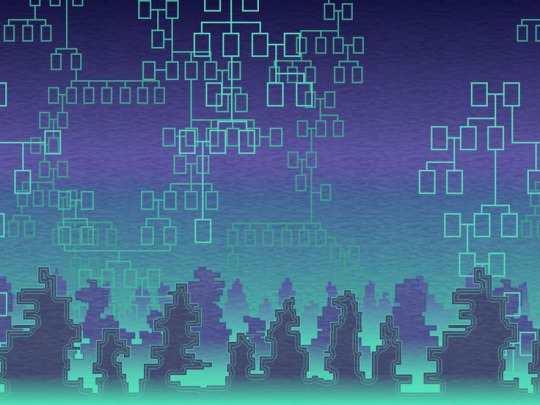
(A/N): As you can see, I am missing chapter 8, because I have already exceeded the limit of images, but I will take a separate part of it because I think its story is worth it. I hope you liked it!
13 notes
·
View notes
Text
King of Lineland: a second dimension, thats stupid, you're insane there is no such thing!
A Square: a third dimension,thats stupid. you're insane there is no such thing!
A Sphere: A fourth dimension, that's stupid.you're insane there is no such thing!
17 notes
·
View notes
Text
Here's a post with tips for writing your own image descriptions.
If you have Flatland OCs you regularly post art of, and would like to help me at least tag them properly, here are the tags I use for this blog, saved to a notepad for easy copying and pasting as needed.
If you want to help, you can go through these and create a specific tag cluster for your different OCs for me to copy and paste.
Just pick out whatever here is relevant to your OCs, and put it in a paragraph, separated by commas. It should include their name, anything you think people would want to search for (like Queer characters), and if applicable, the title of any stories they appear in.
I have been considering adding tags for the shapes of each characters, so you can add that in as well. (Ie: Rectangle, Cube, Straight Line, Kite, ect)
Then you can send me the results in an ask, and I'll be able to save those to a document, so all I have to do when I reblog your OCs is copy it in and all the right tags will show up.
You can have each character's tags separated by a paragraph.
IE:
Billie: [paragraph of tags separated by commas]
Bomb: [paragraph]
Joe: [paragraph]
I'm not sure what the character limit is for asks these days, but feel free to send as many at a time as you can fit in an ask.
Including the names of the characters in your art whenever you post them will also help.
_____
described images, described art, Flatland, Flatland art, Flatart,
transcribed audio, transcribed lyrics, lyrics, music,
Photoedits,
Physical books,
Flatland a Romance of Many Dimensions, Flatland Illustrations,
Book collections, Flatland collections,
The Color Revolt, Configurationism, Circularchy,
Stylized form, Literal form,
Flatland animals, Flatland rabbit, Flatland bees, Flatland horse, Flatland chicken, Flatland dog, Flatland cat, Flatland mouse,
Flatland technology,
Flatland anatomy, Flatland worldbuilding, Flatland cosmology, Flatland structure,
A Square, A Sphere, The Grandson of a Square, A Square's Wife, The Wife of A Square, The Sons of A Square, The Great Great Great Great Great Grandfather of A Square, The King of Lineland, The Monarch of Pointland, Chromatistes, Chromatistes the Pentagon,
memes, Flatland memes,
Public domain characters in Flatland, Flatland versions of characters,
Public domain characters,
Family Trees, Comic, Animation,
Flatland OCs, Original characters, Flatland original characters,
Character reference,
Disabled characters, Neurodivergent characters, Physically disabled characters, Characters with mobility aids, Characters with disability aids, Characters with prosthetics, Characters with canes, Characters with walkers, Characters with swimmers, Characters with glasses, Characters with wheelchairs, Characters with chairs, Characters with sleds, Characters with crutches, Characters with rollators, Characters with scars, Characters with facial differences, Characers with limb differences, Characters with visual impairment, Blind characters,
Queer characters, LGBTQIA+ characters, Gay characters, Bi characters, mspec characters, Lesbian characters, Trans characters, Nonbinary characters, Characters who use neopronouns, Aroace characters, Aspec characters,
Black Characters, Characters of color,
Irregular characters, Deirregular Characters,
Werestars, Stellanthropes, Shapeshifters, dragons, serpents, weredragons,
Characters with wings,
Sphereland, Flatterland, The Arts of Being, The Breaking Point, Neopronouns in Action, Flat Dreams, Flatterland, Flatland the film 2007, Flatland the movie 2007,
Neopronouns in Action 062, Neopronouns in Action,
Neopronouns in Action 090, Neopronouns in Action,
A 2024 Flatland Summary,
Tarzan of the Apes, Mickey Mouse,
Dayo,
Esther Flat Dreams, Nora Vigenere, Nora Flat Dreams,
Pollux Codex, Madelyn Schwarz-Carver, Hunter Schwarz, Marianne Smith, Michael the Misogynist Pentagon, Providence, Nature, Providence and Nature, Germs, Mr Square, A Shape,
Oblisi,
Liam,
A Son of A Square,
Cy,
Frau Line,
Lily Cipher,
Ruth Galton, Ruth, Liz, Elizabeth Huntsworth, Stella, Orbis, Irene Huntsworth, Mama Huntsworth, Chief Jr, Atlas Huntsworth, Atlas, Vance,Vance Huntsworth, Elijah, Elijah Huntsworth, Jasper,Jasper Huntsworth, 01 Isosceles,
Vincent, Trey,
Rutabega,
Hauntlight the Irregular Line, Cenotaph the rabbit aether, Sirenade the Irregular Multiangulus, Raptigan the _, Avispa Oro, Beatris Baker, Mo Guy, Unnamed characters, Billie Bob and Joe, Billie the Straight Line, Bob the Circle, Joe the Hexagon,
Jerult the Irregular Kite, Cairis Garret the Equilateral Triangle, Letel the Isosceles Triangle, Aralinda the Straight Line, Leteralinda the Straight Line, Ambrosine the Straight Line, Lucille the Straight Line, Carolayn the Kite, Tristram the Isosceles Triangle,
Arsenn Lupin, Arsene Lupin, AScrossover, Arsene Lupin crossover, Ortence Daniel, Hortense Daniel,
Flyssa of Ib-Wa, Dearg of Ib-Wa, Lieutenant Kellite the Configurationist, Grandna Tuokeli,
Vikki Line, Victoria Line, Lee Line, Jubilee Line,
Huffy,
Bill Cipher, Gravity Falls, GFcrossover, The Book of Bill, The Mother of Bill Cipher, The Father of Bill Cipher, Dipper Pines, Mabel Pines, Ford Pines, The Axolotl, Andrew Kryptos, The Mosaic,
Carlton,
Randie,Gravity Falls, GFcrossover,
Spacelanders, Flatlanders, Linelanders, Pointlanders, Hyperspacelanders, Higher Dimensional Beings, Beings From Unknnown Dimensions, Planiversers,
Alternate Universe Forms,
Video, autoplay, GIF, Autoplay, WIP animation, Unnamed Animation 001, Animation,
Flatland Merch, Art you can buy, Art you can print,
Art templates,
plush, plushies, arts and crafts,
Ty for adding it to the original,:), ID added in reblog, ID in original,:),
Plain text ID added in reblog, Original ID in ALT text, :),
6 notes
·
View notes
Text
Part II: Other Worlds
"O brave new worlds, that have such people in them!"
Section 13. How I had a Vision of Lineland
[Table of Contents]
It was the day before the last day of the year 1999, and the first day of the Holiday Vacation.
Having stayed up late, amusing myself with my favorite Geometry problems, I went to my bed with an unsolved math problem in my mind.
That night, I had a dream.
I saw in front of me a huge number of small Straight Lines, which I naturally assumed to be Women, along with some other Beings that were smaller, and appeared to me as glowing Points.
They were all moving from side to side in, as far as I could see, a single huge Straight Line, all moving at the same speed.

[Image description start: A black and white digital illustration titled, "My view of Lineland". The diagram shows a square, labeled, "myself" with an eye on a lower corner labeled "my eye", looking down at a row of lines and dots. In the center of the row is a line slightly longer than the others, labeled, "the king", with eyes on either side. On either side of the king are a few more lines labeled "men", followed by a shorter line, labeled "a boy", and several dots, labeled "women". Below this is text in parenthesis reading, "(The King's eyes much larger than the reality showing that His Majesty could see nothing but a point.)”. Image description end.]
As they moved, they made a continuous, jumbled chirping or twittering noise. But sometimes they stopped moving, and when they held still, there was silence.
Approaching the largest of what I thought were Women, I said, “Woman, what is the purpose of this area? Why are you all making these chirping noises and moving back and forth in a Straight Line?”
But she didn’t react.
I repeated myself a second time, and a third, but still got no response.
Finally losing patience with what I thought was extreme rudeness, I shoved forward and brought my mouth directly in front of her, to stop her from moving forward again, and loudly repeated my question for a fourth time: “Woman, what is the purpose of this area? Why are you all making these chirping noises and moving back and forth in a Straight Line?”
“I am no Woman,” replied the small Line, “I am the Monarch of the world. But you, where have you come from to intrude into my world of Lineland?”
Surprised by this sudden answer, I apologized if I’d startled or annoyed his Royal Highness, but, explaining that I was a foreigner, I asked to King to give me some information about his World.
But I had a very hard time getting any information from him that actually interested me, because the Monarch kept assuming that whatever was obvious to him, had to be obvious to me, and decided that I was just pretending not to understand as a joke.
However, by persevering in my questioning, I got the following facts:
It turned out that this poor, ignorant Monarch – as he called himself – was under the impression that the Straight Line that he called his Kingdom, where he spent his entire life, was the only thing not only in this World, but the entire Universe.
Unable to move or to see, except for what was inside his Straight Line, he had no idea that anything existed outside it.
He had “heard” me the first times I’d spoken to him, but the sound of my voice had been so unnatural and confusing that he’d made no answer.
As he explained, he’d seen no one, and my voice had seemed to come from inside him, as though from his own intestines.
What I called his “side”, he called his “insides”, and to him, my voice had been nothing but a confused jumble of sounds beating against his stomach.
Until I had placed my mouth in his World, he’d been unable to understand me, or see me, and he still had no idea where I’d come from.
Outside his World, or Line, everything was blank to him. But no, because even the word blank implies Space – it simply didn’t exist.
His subjects – with the Lines being Men and the Points being Women – were all just as trapped in that single Plane of motion and vision in that single Straight Line, which was their whole world.
The only thing they could ever see was a Point.
Man, woman, child, object, all were nothing but Points to the eye of a Linelander. Only the sound of the person’s voice could tell you their Sex or age.
And because each individual took up the entirely of the “narrow path” of their Universe, this meant that no one could move to the side, and no one could move past anyone else. Once neighbors, always neighbors.
Neighborhood for them was like marriage for us. Neighbors stayed neighbors until Death came to part them.
Such a life, with nothing to see but a Point, and motion only possible in a Straight Line, seemed to me to be unspeakably miserable, and I was surprised at how cheerful and full of life the King was.
Wondering how it could be possible for these Linelanders to reproduce when their circumstances seemed so hostile to the possibility, I hesitated for a long time to question his Royal Highness on such a private subject, but at last I had to give into my curiosity, and casually asked about the health of his family.
“My wives and children,” he replied, “Are healthy and happy.”
I was staggered by this answer, because, as I said before, the only people anywhere near the King were Men.
I dared to reply, “Pardon me, but I don’t understand how your Royal Highness can see, let alone approach their Majesties, when there are at least half a dozen people between you, which you can’t go or look past? Do you mean to tell me that in Lineland, touching isn’t needed for marriage, or for the creation of children?”
“What kind of absurd question is that?” demanded the Monarch. “If touching were required, the Universe would soon run out of people! No, no. Neighborhood is not needed for the union of hearts, and the birth of children is too important to be left up to the random chance of proximity! You have to know this. But since you think it’s funny to pretend you don’t, I will explain it to you like you’re the most uneducated child in Lineland.
“Listen well. Marriages are made by the senses of sound and hearing. You are of course aware that every Man has two mouths, voices, and eyes – a deeper bass on one side, and a higher tenor at the other. I wouldn’t bother to mention this, except that I haven’t been able to hear your tenor voice while we’ve been speaking.”
I told him that I had only one voice, and that I hadn’t been aware that his Royal Highness spoke with two.
“That confirms my theory,” said the King, “That you are not a Man, but a Female Monstrosity with a deep voice, and an utterly uneducated ear for music. But, let us continue.
“Nature herself declared that every Man should marry two wives, and—”
“Why two?” I interrupted.
“You’re taking this joke too far!” he cried. “How else can there be a harmonious union without the combination of the Four in One? The Bass and Tenor of the Man, and the Soprano and Contralto of the two Women?”
“But what if,” I said, “a man wanted to have only one wife, or three?”
“That is impossible.” he said, “It is as inconceivable as saying two plus one equals five, or that the human eye could see a Straight Line.”
I would have interrupted him again, but he continued, saying:
“In the middle of each week, a Law of Nature compels us to move forward and backward with a rhythm faster than normal, which lasts a hundred and one seconds.
“In the middle of this dance, at the fifty-first moment, the inhabitants of the Universe suddenly stop in place, and each individual sings out his richest, fullest, most beautiful song. It is this moment that all of our marriages are made.
“So powerful is the evolution of Bass to Treble, and Tenor to Contralto, that the Loved Ones, even if they’re twenty thousand leagues apart, can still instantly recognize the voice of their destined Lover, and, cutting through the pathetic obstacle of distance, Love unites the three.
The marriage is consummated in that moment, and results in the birth of three children who take their place in Lineland.”
“What?! Always three?” I asked, “Does one wife always have to have twins, then?”
“You bass-voiced Monstrosity, yes!” replied the King. “How else could the numbers of the Sexes stay balanced, if two girls weren’t born for every boy? Do you want to defy the very Laws of Nature?!”
He stopped talking, speechless with fury.
It took a while before I could convince him to continue his explanations.
“Do not assume, of course, that every bachelor finds his mates at his first try at this universal Marriage Song. On the contrary, it’s normal for the ritual to be performed many times before it is successful. Few are lucky enough to instantly recognize the voices of the partners destined to them by Providence, and complete the harmonious embrace. For most of us, it takes a long time to successfully marry.
“The Man’s voice might perfectly match up with one of his future Wives, but not the other, or sometimes, not with either at first. In cases like this, Nature declares that every weekly Chorus will bring the Lovers closer into harmony.
“Each test of their voices allows them to discover where they are going wrong, and gives them the opportunity to change accordingly. And after many tests and adjustments, eventually the marriage is achieved. There comes, at last, the day when the three distant Lovers suddenly find themselves in exact harmony, and before they even realize it, the married Triplet is being celebrated by Nature as one more marriage, and three more births.”
[Table of Contents]
4 notes
·
View notes